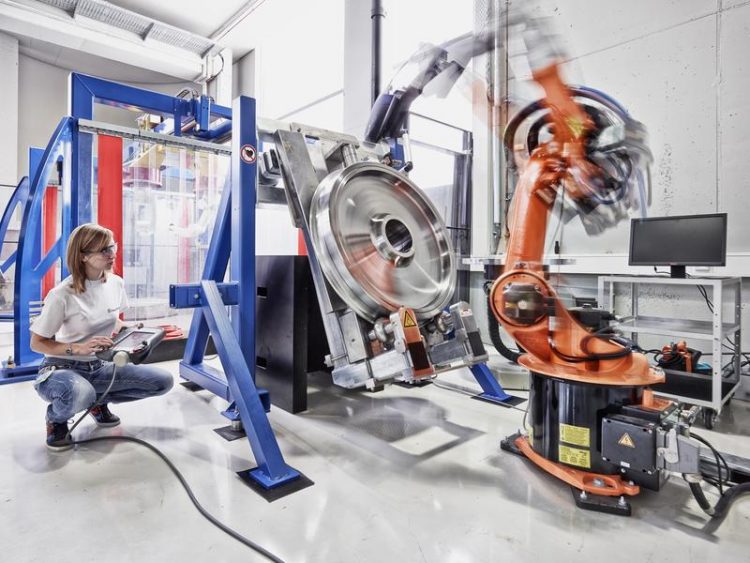New brooms sweep clean – innovative nondestructive testing en route to standardization

Robotics-assisted thermography at a rail wheel Uwe Bellhäuser
The industrial demand for manufacturing-accompanying nondestructive inspection by standardized methods has grown steadily in recent years. Compared to established standardized procedures novel approaches of nondestructive testing methods offer tremendous progress and improvements such as shorter testing times, high automation, reduced equipment and training costs, lower susceptibility to operating error, among other things.
Nevertheless, their comprehensive industrial spread is hindered by a lack of standards and standardization. So often the user cannot provide proof of test equipment aptitude of the procedure for the specific problem because of high costs, lack of resources and/or lack of interdisciplinary methodological skills.
In particular, SMEs as suppliers are facing reasoning difficulties for warranting the use of non-standard test methods or even expose themselves to a high degree of financial risk. Thus, existing potential savings in time and expense while improving quality cannot be exploited, whereby the position of German SMEs in the global economic system is weakened.
Inductively excited thermography is a not yet standardized but already widespread alternative to traditional magnetic particle testing (MT). The test method is ideal for fully automatic semifinished goods inspection of metallic parts and components.
Unlike MT, inductive thermography provides the evaluation of the defect depth. Moreover, in most cases there is no need to remove surface coatings and the subsequent cleaning of the surface is completely eliminated. To date, also in this case a comprehensive acceptance is, however, obstructed by the lack of standardization.
In the near future, engineers of the Fraunhofer Institute for Nondestructive Testing IZFP in Saarbrücken together with industry representatives will work out specific solutions that will pave the way for standards and standardization of new inspection methods.
The general objective of this project is to strengthen the competitiveness in particular of small and medium-sized enterprises. To this, amongst others a standardization procedure for the inductive thermography is triggered, the conclusion will significantly facilitate access to this inspection technology.
Represented by the Institute for Standardization e. V. (DIN) and the German Aerospace Center (DLR) as executing agencies, the research project is funded since September 2014 to February 2016 by the Federal Ministry of Education and Research (BMBF) with more than 100,000 euros.
Media Contact
All latest news from the category: Process Engineering
This special field revolves around processes for modifying material properties (milling, cooling), composition (filtration, distillation) and type (oxidation, hydration).
Valuable information is available on a broad range of technologies including material separation, laser processes, measuring techniques and robot engineering in addition to testing methods and coating and materials analysis processes.
Newest articles

A universal framework for spatial biology
SpatialData is a freely accessible tool to unify and integrate data from different omics technologies accounting for spatial information, which can provide holistic insights into health and disease. Biological processes…

How complex biological processes arise
A $20 million grant from the U.S. National Science Foundation (NSF) will support the establishment and operation of the National Synthesis Center for Emergence in the Molecular and Cellular Sciences (NCEMS) at…

Airborne single-photon lidar system achieves high-resolution 3D imaging
Compact, low-power system opens doors for photon-efficient drone and satellite-based environmental monitoring and mapping. Researchers have developed a compact and lightweight single-photon airborne lidar system that can acquire high-resolution 3D…





















